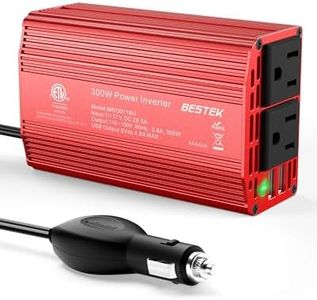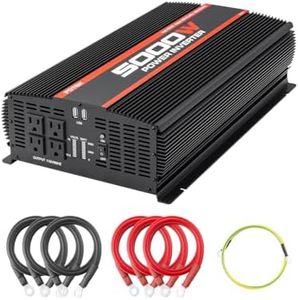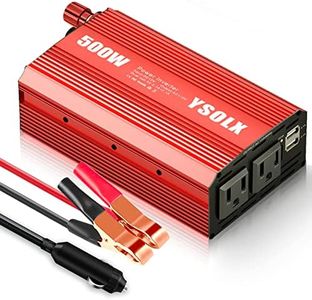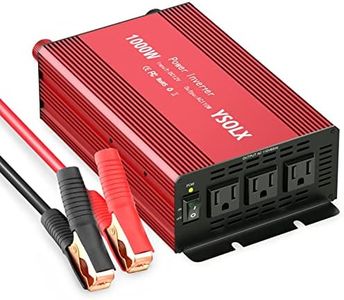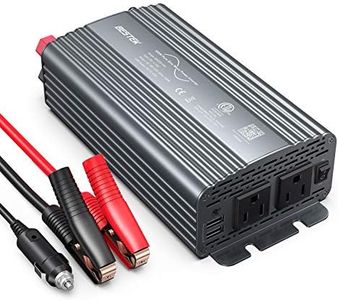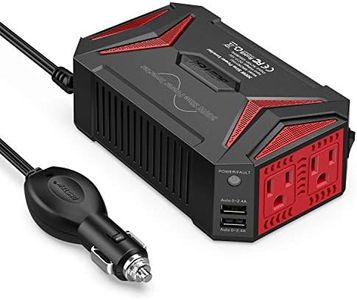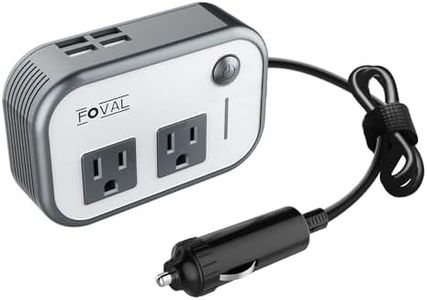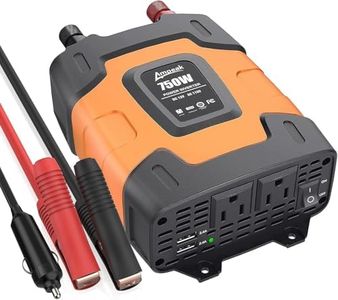10 Best Compact Power Inverters 2025 in the United States
Our technology thoroughly searches through the online shopping world, reviewing hundreds of sites. We then process and analyze this information, updating in real-time to bring you the latest top-rated products. This way, you always get the best and most current options available.

Our Top Picks
Winner
BESTEK Power Inverter DC 12V to AC 110V - 300W Car Plug Adapter Outlet with 4.8A Dual USB Fast Charging Port - Car Charger Cigarette Lighter Adapter for Phone, Laptop on Road Trip - Aluminum Housing
Most important from
33640 reviews
The BESTEK 300W Power Inverter is a reliable choice for those needing a compact solution to convert DC to AC power in vehicles. It delivers 300 watts of continuous power and up to 700 watts of instantaneous power, making it suitable for charging devices like laptops and tablets via its two AC outlets. Additionally, it has two USB ports (up to 2.4A) for smaller electronic devices.
The inverter is designed for 12V batteries, which works with most vehicles but not with models like the Tesla Model Y. One of its strengths is its portability; it is lightweight, weighing only 14.4 ounces, and compact enough to fit easily in a vehicle. The 24-inch cigarette lighter plug adds to its convenience, allowing it to be used in almost any car. Safety is a priority with this inverter, featuring a built-in 40-amp fuse and protections against overheating, under and over voltage charging, and short circuits.
The durable metal housing provides protection against physical damage, and the smart cooling fan ensures it operates quietly and efficiently. Users should be mindful that this inverter may not be suitable for high-power appliances and is limited to devices that are compatible with its 300W capacity. The fan, while generally quiet, can become noisier when the power exceeds 70W. This product is best suited for users looking for a compact, efficient inverter for standard vehicle use, especially for vacations, work trips, and camping.
Most important from
33640 reviews
BESTEK 300W Power Inverter DC 12V to 110V AC Car Charger Converter with 4.2A Dual USB Ports and 2 AC Outlets Adapter (Black)
Most important from
33640 reviews
The BESTEK 300W Car Power Inverter is a solid choice for anyone needing reliable power while on the go, especially for laptops, tablets, and USB devices. It offers 300 watts of continuous power with a peak of 700 watts, which is enough for most small electronics used in a car. It has two AC outlets and two USB ports, making it convenient to charge multiple devices at once. The inverter typically provides modified sine wave output, which works fine for most devices but may not be ideal for sensitive electronics.
Its compact size—roughly the size of an iPhone—and lightweight design make it very portable, perfect for travel, camping, or work trips. Safety features like a built-in 40-amp fuse and protections against overheating, over/under voltage, and short circuits add peace of mind. The durable metal housing and smart cooling fan help keep it quiet and resilient during use.
One downside is that it plugs into the cigarette lighter socket, which limits power input to a vehicle’s 12V system and means it won’t work for devices needing more power. Also, while the dual USB ports provide 2.4A total, they’re not the fastest charging speed available today. This inverter suits casual users who want a compact, reliable, and safe power source for basic devices in their car.
Most important from
33640 reviews
200W Power Inverter for Dewalt 20V, DC 20V to AC 110-120V Battery Inverter, Portable Power Station Generator, Charger Adapter Battery Powered Outlet with 2 USB Ports & 1 Type-C & 1 AC Outlet
Most important from
1833 reviews
This 200W power inverter by LIVOWALNY is designed for use with DeWalt 20V lithium-ion batteries, making it a compact and portable solution for powering small electronics like laptops, phones, tablets, and cameras when you're off-grid or during power outages. It converts 20V DC from the battery into standard 110-120V AC power, which is handy for everyday devices. The inverter includes one AC outlet along with two USB ports and one fast-charging Type-C port, giving flexibility to charge multiple devices simultaneously.
The device is lightweight (about 0.3 kg) and compact, which makes it easy to carry around for camping or travel. It also features a built-in LED work light with adjustable brightness, adding a practical lighting option. In terms of safety and stability, it has several protections such as against overheating, over-current, and short circuits, plus a fan and ventilation to keep it cool during use.
Keep in mind that the inverter does not include a battery, so you need a compatible DeWalt 20V battery to operate it, which adds to the total cost and weight. The power output is limited to 200 watts, so it’s suitable only for smaller devices and won’t run larger appliances. Also, it has a single AC outlet, which might be restrictive if you want to power more than one AC device at a time. For those needing a lightweight, portable inverter primarily for charging small electronics and who already own compatible DeWalt batteries, this unit offers a convenient and safe choice. For higher power needs, more outlets, or different battery systems, other options should be considered.
Most important from
1833 reviews
Buying Guide for the Best Compact Power Inverters
When choosing a compact power inverter, it's important to understand your specific needs and how different specifications can impact the performance and suitability of the inverter for your intended use. A power inverter converts DC (direct current) power from a battery into AC (alternating current) power that can be used to run various electronic devices. Here are some key specifications to consider when selecting a compact power inverter, along with explanations to help you make an informed decision.FAQ
Most Popular Categories Right Now
